Epilogue
After our rescue, my hospitalization in Guam, and our arrival in San Diego on October 2, my recovery at the Marine Corps Base did not go smoothly. Two days in, an ambulance had to rush me to Balboa Hospital in San Diego with a perforated appendix. But before they could operate, they had to reduce my elevated white-blood-cell count. I had a life-threatening fever requiring twenty-nine days of penicillin.
Finally, the day for surgery arrived. After giving me a spinal tap, they strapped me down on the operating table and began the surgery. I was not put under and was able to watch the procedure on the overhead monitor. Unable to move my arms, I told the nurse standing by my head that my nose was itching. She quickly addressed the situation with a tissue and a good rubbing. But my relief was short lived, and a few minutes later I had to complain about it again. This time, however, a white-haired gentleman in a white uniform and mask standing near my bed repeated what the nurse had just done. When he was finished, the nurse leaned over and asked me, “Marine, how does it feel to have an admiral rub your nose?” All I could think to say was, “Thank you, sir.”
In January of 1946, after spending three months at the hospital in San Diego, I was sent to Great Lakes, Illinois, where I was discharged from the Marine Corps. As it turned out, all the documentation of my promotion to sergeant (two days before the sinking) went down with the ship, so it was never official and I was discharged as a corporal. I then went back home to Murray, Kentucky, and enrolled in college. But the wounds of war were still too fresh, too distracting. More healing needed to take place, more time needed to pass. So after my freshman year I decided to go to work with my father in construction.
In July of 1947, I married Ola Mae Cathey, the same brunette who caught my eye in high school four and a half years earlier. Together we had two children, Cathey and David, and we now have eight grandchildren and eight great-grandchildren.
God didn’t stop after blessing me with a wonderful family. He blessed me in the business world as well. In 1950 I became a distributor for the Pella Window Company in Iowa City, Iowa. A year later I transferred to the Quad Cities and established an office in Rock Island, Illinois. There the Lord allowed me to prosper, and I was able to expand my territory into three states. I eventually sold my business in 1985.
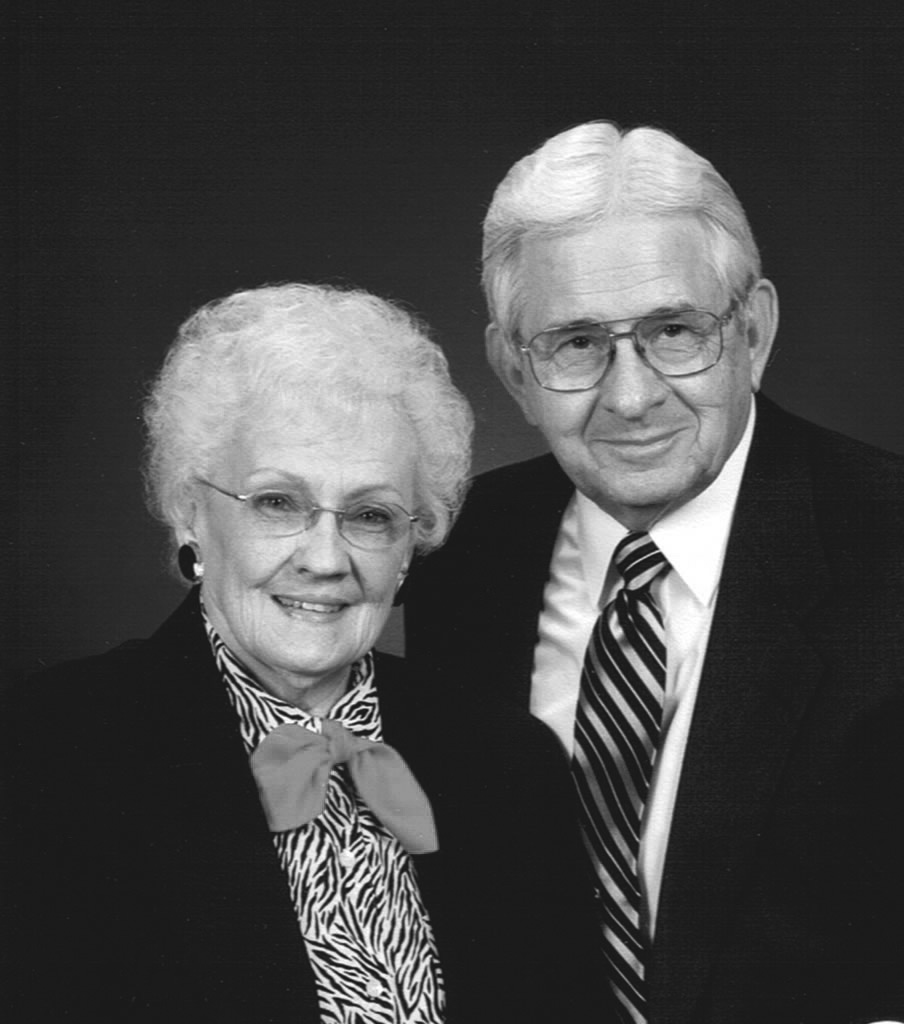
Ola and me on our 50th wedding anniversary (1997).
During those years I was actively involved in my local church as both a leader and lay teacher. I also served as a trustee for the Moody Bible Institute for over fifteen years. After retirement I moved to Paris, Tennessee, close to my birthplace, and then in 2006 I moved to Clarksville, Tennessee, where I commute to the church my son, David, pastors near Nashville. I continue to travel all over the country telling my story and giving God the glory for rescuing me not only out of the depths of the ocean, but more important, out of the depths of my sin. All I want is to remain a faithful husband, father, grandfather, and great-grandfather, and to be a testimony of God’s transforming and saving grace.
No one can possibly fathom the horrors of war unless they have experienced them firsthand. To be sure, no one can comprehend what that entire generation endured during that hellish Second World War. But we not only survived—somehow we thrived. In his book The Greatest Generation, Tom Brokaw says my generation is “the greatest generation any society has ever produced.” Whether or not that is true, I know that my generation certainly did not come through it all unscathed. For many, the war didn’t end with the Japanese surrender, especially for those who suffered extreme physical and psychological trauma like the survivors of the USS Indianapolis. Some of my buddies succumbed to alcoholism, depression, or even suicide.
At first I, like all the others, tried to forget what happened. But certain sights, sounds, and smells would trigger my memory and instantly take me back to places I didn’t want to go. I could see suicide planes and the bow cut off the ship, hear explosions and bulkheads breaking, and on and on. It was six months after I got home before I finally acquiesced to the constant queries of a respected friend and allowed myself to talk about what happened. Once I got started, I found that I couldn’t stop. Finally, my father tearfully said, “Son, that’s enough for now.” It was the first any of them had heard about what actually happened, and it was more than they could bear.
Years later while in Hawaii on a business trip, I decided to walk down to the edge of the ocean. But when I got close, I stopped and stared. It was as though I was in a hypnotic trance. As I looked out at the open sea, suddenly I could see myself swimming. I could see sharks, the faces of shipmates, and bloated bodies. I could even hear men screaming. Finally, I realized I had to walk away.
To this day I will not set foot in the ocean. But by God’s grace I was gradually able to separate my past from the present and joyfully anticipate the future. I understand more fully what the apostle Paul means when he says, “If you have been raised up with Christ, keep seeking the things above, where Christ is. . . . Set your mind on the things above, not on the things that are on earth. For you have died and your life is hidden with Christ in God” (Colossians 3:1–3).
Lifelong Bonds
There remains a special bond between the survivors and our families even to this day. The fiery crucible of our ordeal at sea has, for many, tempered the steel of our faith in God and forged a powerful sword of patriotism for the country we love. Every other year the survivors and our families and friends meet in July in Indianapolis, Indiana, for a reunion—a wonderful season of fellowship, worship, and memorial.
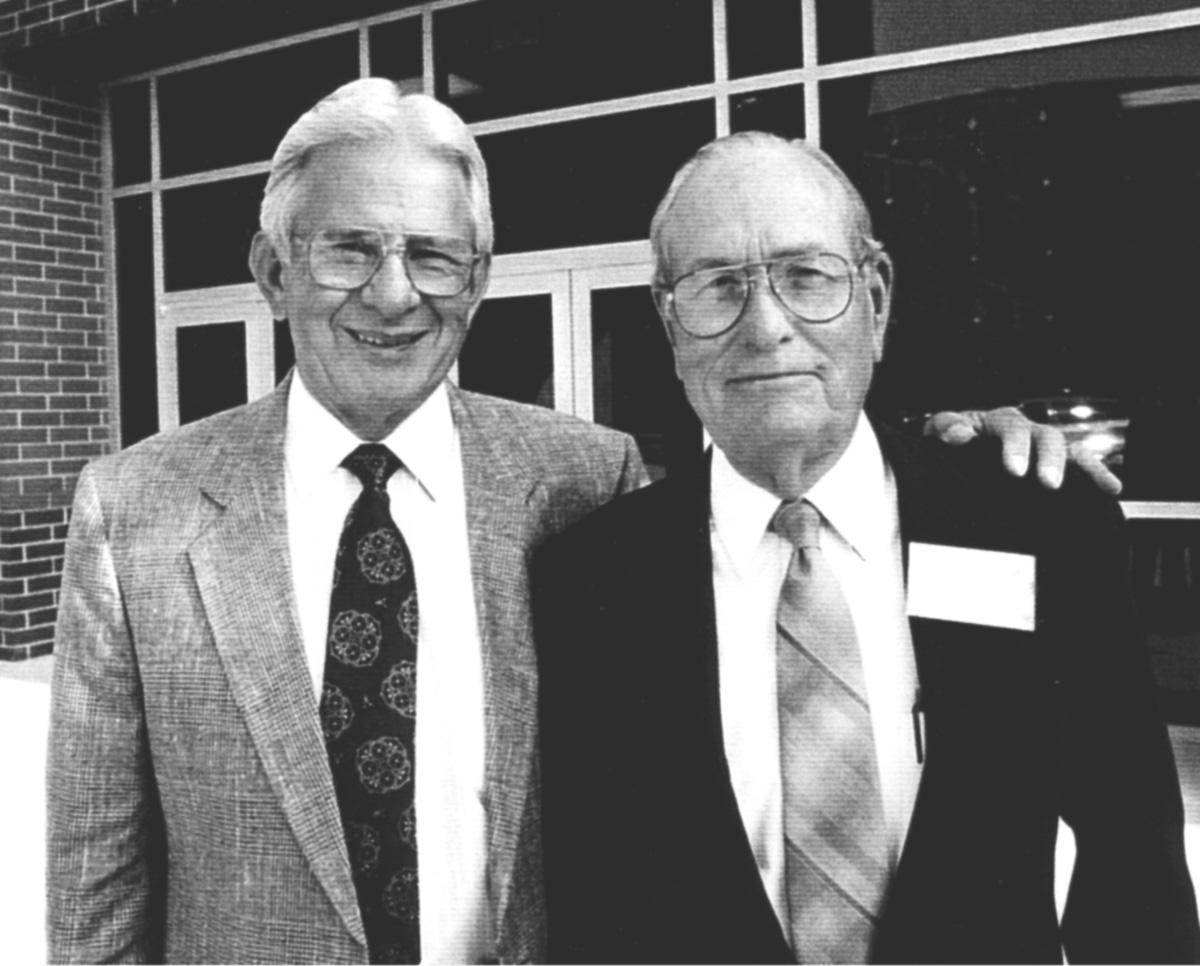
At our 1990 survivors’ reunion, I posed with Charles McKissick, the only shipmate still alive from our group when we were rescued, forty-five years earlier.
The USS Indianapolis (CA-35) Survivors’ Organization designed, erected, and financed the USS Indianapolis National Memorial in honor of the ship and her crew. Located at the north end of the Canal Walk in Indianapolis, it was dedicated on August 2, 1995. That same year it was designated a National Memorial by an act of Congress, one of only twenty-six such memorials. It is essentially a beautifully landscaped park open to the public twenty-four hours a day, seven days a week. A stately monument resembling the Indianapolis graces the site, with the names of the ship’s company and one passenger who made up her final crew engraved on its south face.
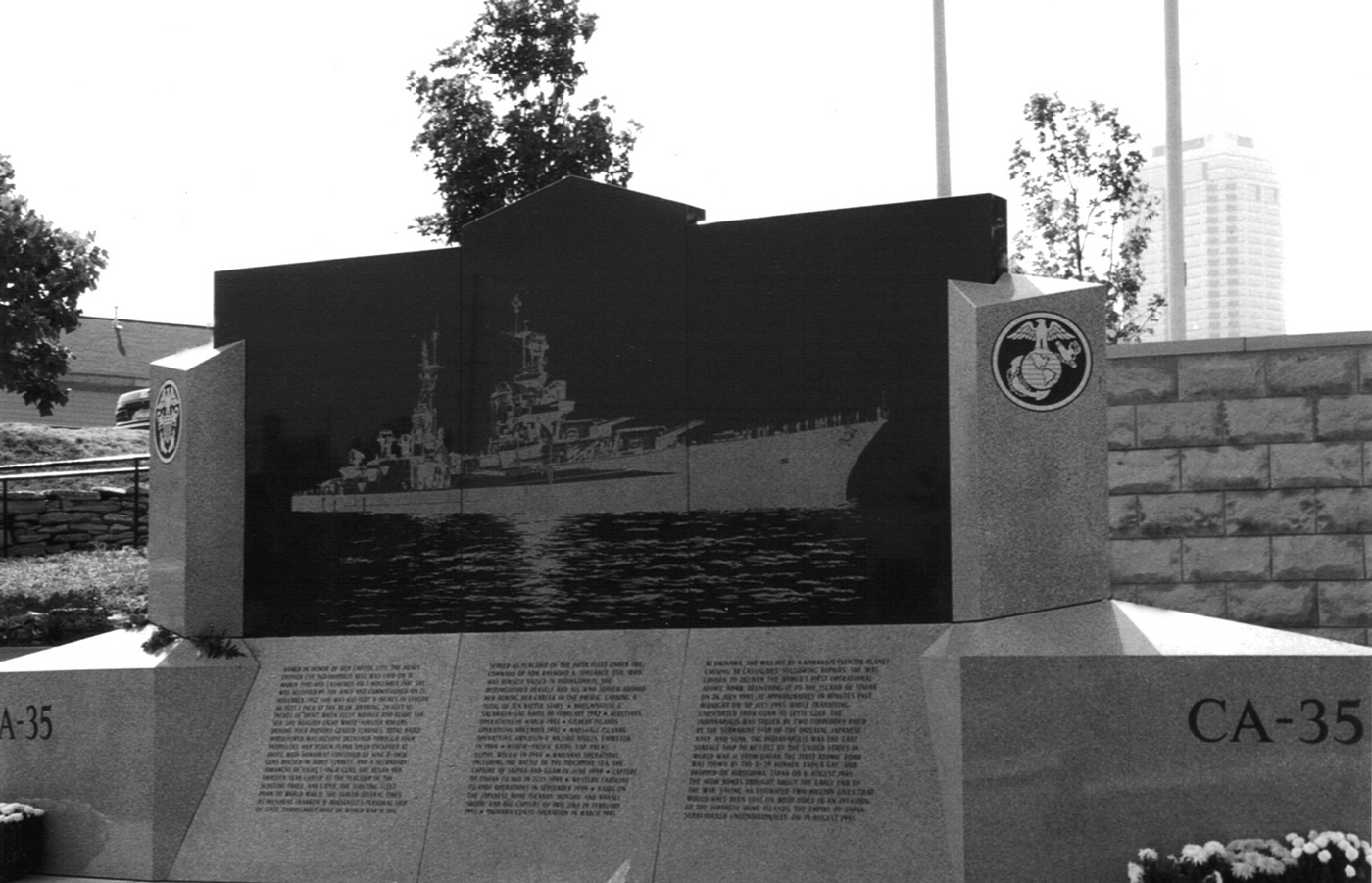
Our survivors’ organization designed, erected, and financed the USS Indianapolis (CA-35) National Memorial in honor of the ship and crew. It was dedicated on August 2, 1995.
Families, friends, and supporters of the men of the Indianapolis have now formed an organization called the Second Watch, dedicated to assist the USS Indianapolis Survivors’ Organization and to promote citizenship and patriotism in our beloved country. I applaud their efforts. We must continue to remind our children that freedom is not free. And for this reason, many brave men and women have sacrificed their lives for this great nation.
Due to the treacherous terrain and enormous depths in the Philippine Sea where the Indy was sunk, recent attempts to locate the ship have proven futile. After a grueling exploration, the crew of an expeditionary vessel named the Sea Eagle concluded that their disappointing search must be abandoned. Consequently, the passengers, explorers, and a few Indy survivors on board conducted a most appropriate and appreciated memorial service. An American flag presented to the Indianapolis survivors by Admiral Tom Fellin was draped over a makeshift raft. A simple block of granite was placed on the flag, along with a plaque commemorating the ship and her crew.
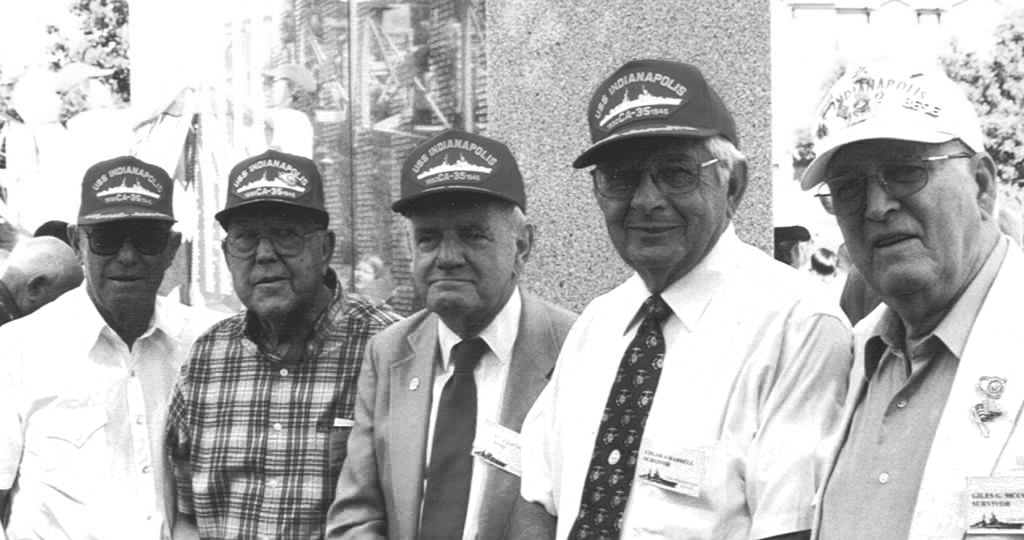
Five Marine survivors at our 2002 reunion (left to right): Earl Riggins, Jacob Greenwald, Melvin Jacob, me, and Giles McCoy.
After a brief memorial service, the “memorial barge” was solemnly lowered into the water off the fantail of the ship to float in silent honor of the sacrifice that was once made in that place. After a few minutes, the crew tugged on the line to tip the raft, symbolically reenacting what happened on that tragic July night in 1945. Once again, a sacred cargo slipped into a watery grave. While I was not there, I can vividly imagine the flag and the memorandums sinking into the final resting place of my shipmates. I hope that this act of honorable remembrance will bring comfort to the families who still mourn.
The USS Indianapolis Lives On
On January 5, 1980, my wife and I were among a number of other survivors and their wives who celebrated the commissioning of another USS Indianapolis—a Los Angeles–class submarine, the USS Indianapolis (SSN-697). The official ceremony took place in Groton, Connecticut. Eighteen years later, the Indianapolis was decommissioned and stricken from the Naval Vessel Register. The final captain of the Indianapolis, William J. Toti, has remained a faithful defender of Captain McVay and is rightly considered part of our family of survivors.
But the legacy of the USS Indianapolis did not end there. In August 2013, Secretary of the Navy Ray Mabus sent a very exciting letter to each of the survivors announcing yet another ship to bear the name USS Indianapolis.
Dear Mr. Harrell,
The tragic sinking of USS INDIANAPOLIS (CA-35) and struggle for survival in shark-infested waters of nearly 900 crewmembers has long been a testament of enduring courage, determination and resolve in U.S. Naval history. As one of the 317 men who lived through this horrific experience, you and your shipmates alone fully understand how such an experience would ultimately affect your life, just as it affected the Navy as a whole and is to this day woven into the fabric of every Navy Sailor.
As a maritime Nation, our security, our economy and our diplomacy rely upon our freedom of the seas in times of peace and our command of the seas in time of war. We go to the sea in ships and submarines whose names serve as an inspiration to their crew and as a warning to those who would threaten those freedoms we hold most dear. The U.S. Navy has bestowed the name “INDIANAPOLIS” on only one other occasion—a Los Angeles Class submarine that served in commission for 18 years from 1980 to 1998.
To honor the history of your crew, I am pleased to tell you I have notified Congress that, pending authorization and appropriation, I intend to name the next Littoral Combat Ship (LCS) USS INDIANAPOLIS. Once again, the name INDIANAPOLIS will be put to sea on the stern of a U.S. Navy warship carrying on the tradition of service that you and your shipmates have forever associated with the name.
A fast, agile surface combatant, the LCS provides the required war fighting capabilities and operational flexibility to execute focused missions close to the shore such as mine warfare, anti-submarine warfare and surface warfare. I sincerely hope you and your family will be able to join in the milestone events that will surround the building and delivery of this fine ship to our Fleet.
Your service to the Navy and the Nation is a testament to the strength of character of Navy Sailors past, present and future. A grateful Navy and a grateful Nation honor that service by sending USS INDIANAPOLIS to sea once more.
Sincerely, Ray Mabus
The Miracle of Reconciliation
Often people ask me, “Do you harbor any resentment toward the Japanese for what happened to you and all the others?” The answer is no. But it took time for me to gain a proper perspective.
Over the years I began to realize that the real enemy was not the Japanese soldiers, sailors, and pilots, as barbaric as many of them were. For the most part they were simply pawns on a political chessboard controlled by those in authority over them. Commander Hashimoto and his crew carried out the orders of their emperor, Michinomiya Hirohito (his rule spanned from 1926 until his death in 1989) and his Imperial cabinet that rubber-stamped his every wish. This included Hirohito’s desire for a Tripartite Pact with Nazi Germany and Fascist Italy to form the Axis Powers in 1940. As laughable as it may seem, their stated objective was “world peace.”
But even if we cast the blame all the way up the chain to the leaders of Japan, Germany, and Italy, we still haven’t gone far enough. I believe in good and evil. I believe in God and His enemy, the devil. The sheer evil that was birthed out of these leaders’ diabolical pact points to this supernatural enemy. He is the fiend responsible for the death and misery of millions of others, not only in that dreadful war, but all wars throughout history.
Everyone has a theology, whether they know it or not. This is mine, anchored in the Word of God. So my resentment for the Japanese gradually shifted to the real Enemy of men’s souls. Man’s only hope in triumphing over sin, Satan, and death is in God alone through faith in the Lord Jesus Christ. “For He rescued us from the domain of darkness, and transferred us to the kingdom of His beloved Son, in whom we have redemption, the forgiveness of sins” (Colossians 1:13–14).
Armed with these eternal truths, I was able to let go of resentment and have compassion on my enemies. I learned to pray that God would be merciful to them as He had been to me. I also understood that we are most like God when we forgive, and that harboring malice only gives an enemy prolonged power to inflict pain.
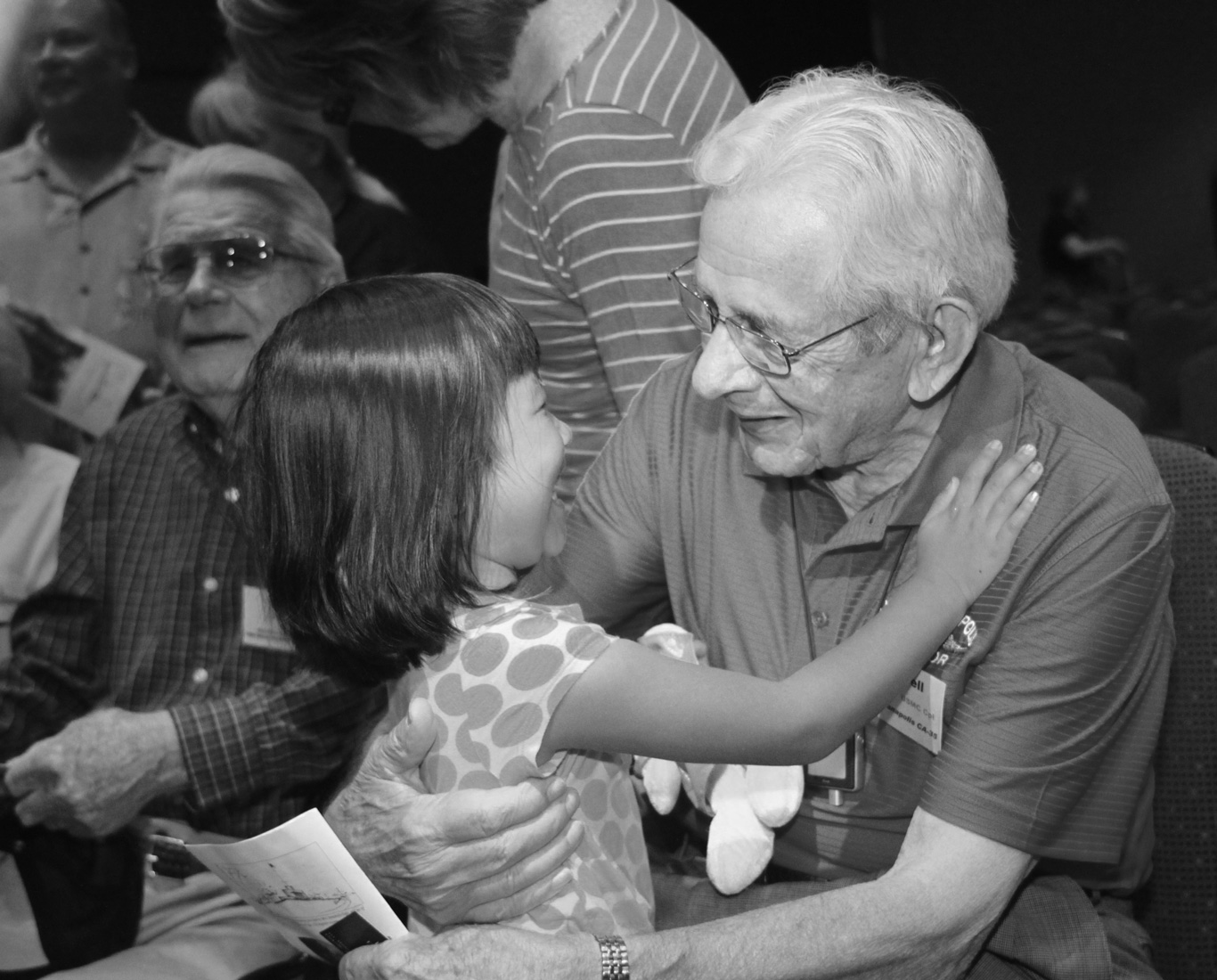
A sweet hug from the great-granddaughter of Commander Hashimoto.
Since then, I have had the privilege to get to know Commander Hashimoto’s granddaughter, Atsuko. She and her family are faithful attendees of every USS Indianapolis survivors’ reunion. This is an incredible act of courage on their part. But it’s important to remember that the atrocities of WWII greatly affected both sides. Hashimoto’s family experienced profound loss in that horrific war. The unthinkable happened. The atomic bomb dropped on Hiroshima instantly incinerated all of the commander’s family (his granddaughter is the progeny of a second marriage after the war).
At the 2013 reunion, Atsuko and I hugged, and she thanked me for opening my arms and receiving her embrace. She told me she wasn’t sure how I would respond. I told her how much it meant to me that she and her family would come to the reunions to honor us and our families. We agreed to build upon this friendship, and we promised to stay in touch.
At Peace
For me, the ordeal of the USS Indianapolis will never be over until the Lord takes me home to be with Him. My experiences on board the Indy and my anguish of soul while lost at sea remain stunning reminders of the sinfulness of man, the providence of God, and His saving grace. My confident hope will always remain in Him, a sentiment shared by the inspired psalmist who said, “Out of the depths I have cried to You, O LORD. Lord, hear my voice! Let Your ears be attentive to the voice of my supplications. If You, LORD, should mark iniquities, O Lord, who could stand? But there is forgiveness with You, that You may be feared” (Psalm 130:1–4).
Occasionally someone will say to me, “So you were one of the lucky ones. . . .” While I appreciate their kind sentiment, I know in my heart that luck had nothing to do with our rescue. In fact, I am convinced that there is no such thing as luck. Our world is not ruled by chance or fate, but by a sovereign God “who works all things after the counsel of His will” (Ephesians 1:11). His providential rule knows no bounds, nor does His omnipotence have limits. For God has said, “The One forming light and creating darkness, causing well-being and creating calamity; I am the LORD who does all these” (Isaiah 45:7).
From the beginning of our creation, God has ordered the events of history to ultimately glorify himself through the person and work of His Son, the Lord Jesus Christ. For “there is salvation in no one else; for there is no other name under heaven that has been given among men by which we must be saved” (Acts 4:12). Every life story either bears witness to His sovereign grace or denies it. But no life has ever been lived apart from the purposes of God. He alone orchestrates the affairs of His creation. Like all the marvelous and mysterious doctrines of God, the coexistence of divine sovereignty and human responsibility remain an incomprehensible paradox to the human mind—certainly one that offends man’s rabid commitment to self-determination. But as I look back over my life through the lens of Scripture, I have no doubt that indeed God is in control, and, without coercion, He uses human means to accomplish His purposes—even the sinking of the USS Indianapolis. I therefore find solace in the inscrutable mysteries of God and relax in the safety of His sovereign rule. It is to His glory that I recount my story—a story that exalts the One who ultimately authored it.
While I would never claim to know the mind of God, I do claim His promise that He “causes all things to work together for good to those who love God, to those who are called according to His purpose. For those whom He foreknew, He also predestined to become conformed to the image of His Son, so that He would be the firstborn among many brethren; and these whom He predestined, He also called; and these whom He called, He also justified; and these whom He justified, He also glorified” (Romans 8:28–30). With these sacred truths resonating within my heart, I am at peace with what God allowed to happen. And I pray that my testimony to the praise of His glory will inspire many to humble themselves before the Lover of their souls in genuine repentance and place their faith in our Savior, the Lord Jesus Christ. To this end I salute my shipmates, their families, and our friends.
Eternal Father, strong to save,
Whose arm hath bound the restless wave,
Who bid’st the mighty ocean deep
Its own appointed limits keep;
O hear us when we cry to Thee,
For those in peril on the sea!
O Christ! Whose voice the waters heard
And hushed their raging at Thy word,
Who walked’st on the foaming deep,
And calm amidst its rage didst sleep;
O hear us when we cry to Thee,
For those in peril on the sea!
Most Holy Spirit! Who didst brood
Upon the chaos dark and rude,
And bid its angry tumult cease,
And give, for wild confusion, peace;
O hear us when we cry to Thee,
For those in peril on the sea!
O Trinity of love and power!
Our brethren shield in danger’s hour;
From rock and tempest, fire and foe,
Protect them wheresoe’er they go;
Thus evermore shall rise to Thee
Glad hymns of praise from land and sea.
The “Navy Hymn” is also known as “Eternal Father, Strong to Save.” The original words were written as a poem in 1860 by clergyman William Whiting of Winchester, England, for a student who was about to sail for the United States. The melody, published in 1861, was composed by fellow English clergyman John B. Dykes.
The hymn, found in most hymnals, is known as the “Navy Hymn” because it is sung at the U.S. Naval Academy in Annapolis, Maryland. It is also sung on ships of the Royal Navy (UK) and has been translated into French.
“Eternal Father,” said to be President Franklin Roosevelt’s favorite hymn, was sung at his funeral. It was also played by the Navy Band in 1963 as President John F. Kennedy’s body was carried up the steps of the U.S. Capitol to lie in state. Roosevelt had served as Secretary of the Navy and Kennedy was a PT (patrol torpedo) boat commander in World War II.1
The “Marines’ Hymn”
From the halls of Montezuma
To the shores of Tripoli;
We fight our country’s battles
In the air, on land, and sea.
First to fight for right and freedom,
And to keep our honor clean;
We are proud to claim the title
Of United States Marine.
Our flag’s unfurled to every breeze
From dawn to setting sun;
We have fought in every clime and place
Where we could take a gun.
In the snow of far-off northern lands
And in sunny tropic scenes;
You will find us always on the job—
The United States Marines.
Here’s health to you and to our Corps
Which we are proud to serve;
In many a strife we’ve fought for life
And never lost our nerve.
If the Army and the Navy
Ever look on Heaven’s scenes;
They will find the streets are guarded
By United States Marines.